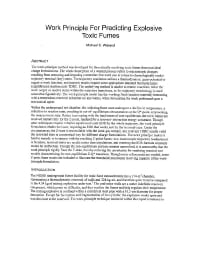Mining Publication: Work Principle for Predicting Explosive Toxic Fumes
Original creation date: February 1998
Authors: MS Wieland
NIOSHTIC2 Number: 20000102
Proceedings of the Fourteenth Annual Symp on Explosives and Blasting Research, Intl Soc of Explosives Engineers, 1998 Feb; :121-135
The work-principle method was developed for theoretically resolving toxic fumes from non-ideal charge formulations. The whole description of a wanted process refers to macroscopic changes resulting from removing and imposing constraints that work one at a time to chronologically render trajectory terminal (key) states. The trajectory resolution utilizes a thermodynamic quasi-potential or negative work function, and numeric results require some appropriate standard thermodynamic (equilibrium) reaction code TDRC. The underlying method is unable to restrict reactions, tailor the work output or resolve states within the trajectory transitions, so the trajectory terminology is used somewhat figuratively. The work-principle model has the working fluid (reaction material) interaction with a tremendous reservoir (chamber and walls), while forecasting the work preformed upon a mechanical agent. Within the underground test chamber, the widening fume zone undergoes a decline in temperature, a reduction in reaction rates, resulting in out-of-equilibrium circumstances at the Q*-point, representing the measurement state. Rather than coping with the hard issues of non-equilibrium, the toxic fumes are resolved numerically for the Z-point, rendered by a zero-net-interaction energy constraint. Though other techniques require complex equation-of-state EOS for the whole trajectory, the work-principle formulation eludes the issue, requiring an EOS that works just for the terminal-state. Under the circumstances, the Z-state is reconcilable with the ideal-gas domain, and relevant TDRC results yield the restricted state in a numerical way for different charge formulations. The work principle makes it hard to remedy or to tamper with the resulting Z-point fumes: non-macroscopic trajectory readjustment is forsaken, terminal states are results rather than stipulations, and resetting the EOS formula constants would be ineffectual. Though the non-equilibrium portion remains unresolved, it is noteworthy that the work principle rigidly fixes the Z-state, thereby reducing the uncertainty for rendering reaction-rate models characterizing the non-equilibrium Z-Q* transition. Though more refinements are needed, some Z-point fume results are included to illustrate the threshold (minimum) resolving capacity of the work-principle formulation.

NIOSHTIC2 Number: 20000102
Proceedings of the Fourteenth Annual Symp on Explosives and Blasting Research, Intl Soc of Explosives Engineers, 1998 Feb; :121-135
- CFD Modeling of Fire Spread Along Combustibles in a Mine Entry
- Evaluation of the Relative Importance of Coalbed Reservoir Parameters for Prediction of Methane Inflow Rates During Mining of Longwall Development Entries
- Experimental and Modeling Investigation of the Effect of Ventilation on Smoke Rollback in a Mine Entry
- Factors Affecting ANFO Fumes Production
- Modeling and Data Analysis of 50 to 5000 kHz Radio Wave Propagation in Coal Mines
- Monitoring and Removal of CO in Blasting Operations
- Reservoir Engineering Considerations for Coal Seam Degasification and Methane Control in Underground Mines
- Theoretical Noise and Propagation Models for Through-the-earth Communication
- Variation of Horizontal Stresses and Strains in Mines in Bedded Deposits in the Eastern and Midwestern United States
- Work-Principle Model for Predicting Toxic Fumes of Nonideal Explosives